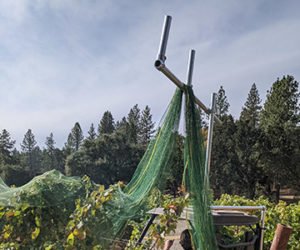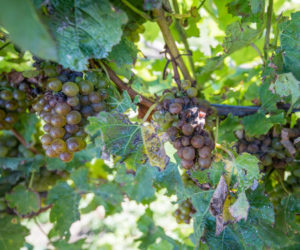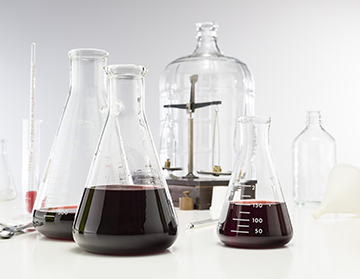
Over the course of an individual’s early experiences as a home winemaker, one will have a few pitfalls and batches that may not be “quite right.” Wines may be perceived as out of balance or to have mild flaws. Many of these balance and flaw issues can be addressed or avoided with some simple lab analysis, both pre- and post-fermentation. Not only can laboratory testing improve the organoleptic qualities of your wines, but it will also provide the winemaker with a deeper understanding of what is actually going on inside of their winemaking vessels. Having some solid metrics of sugar content, pH, total acidity, and free SO2 counts will give the winemaker some criterion to discern a good wine from a bad wine and help to replicate the former in future vintages.
Setting up the Home Lab
When assessing possible workspaces in your home for a laboratory setup, there are a few details that should be considered. You will need a clear workspace and preferably a table or surface that will not be easily corroded, such as stainless steel. Mishaps and spills happen in the laboratory, and non-porous, non-corrosive surfaces are preferred. When evaluating color, wine is viewed against a light background, so having a bright light and a plain white surface such as countertop or cabinetry can be useful. The area should be well ventilated and well illuminated.
A waste sink is also very helpful when setting up a home laboratory. You will be washing out testing beakers and equipment very often. Most wine additives require rehydration with water. Evaluate your water source and quality. If your water is chlorinated then add a chlorine filter. Also consider the hardness of your water and the potential effects the mineral composition will have on your wine and equipment. When in doubt, use distilled water for rehydration and bench trials.
Laboratory Supplies
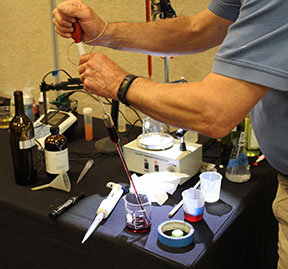
There are many basic supplies that will come in handy when setting up a home laboratory. Some basic measuring implements such as measuring spoons and cups (both in imperial system and metric system are preferred, unless you want to stick only with metric, which is easiest for these measurements) are always useful for measuring volumetrically. Additional measuring implements such as graduated cylinders, glass beakers, and Erlenmeyer flasks are necessary for bench trials as well as pipettes and syringes for measuring smaller amounts. It should be noted that graduated cylinders provide more accurate measurements while glass beakers’ demarcations are often an approximate measurement.
A scale will be needed for measuring by weight as opposed to volume. While a digital scale is preferred and more precise than a mechanical scale, the key factor is accurate calibration. Scales may be calibrated by weighing one milliliter of water as it should equal one gram when measured at 68 °F (20 °C). To enhance your accuracy of measurement, it is preferred to have a digital scale that measures to the hundredth of a gram.
Additional materials such as mixing bowls, a whisk, and assorted sized funnels will also be useful in the home laboratory. A thermometer is also a simple yet crucial piece of equipment in the laboratory. A digital thermometer is easier to read and more accurate than a traditional glass model, but again, the key is calibration. A thermometer can be calibrated to freezing by filling a glass with ice, adding water, allowing to sit for a few minutes, and then calibrating the thermometer to 32 °F/0 °C.
Home Wine Tests
Once you have set up a proper workspace and obtained some basic materials, it’s time to get testing. The basic tests that the home winemaker should strive for conducting in their home laboratory are sugar content (Brix), pH, total acidity, malolactic fermentation, and free SO2. These are the essential parameters to measure wine balance and stability.
There are quite a few different testing kits that can assess each of these parameters. The precision of these kits varies and often correlates to price. I have organized various levels of testing equipment contingent upon production size, with the assumption that the more wine you produce, the more money you should consider investing in your laboratory testing equipment.
Lab Equipment for Beginner Wine Labs
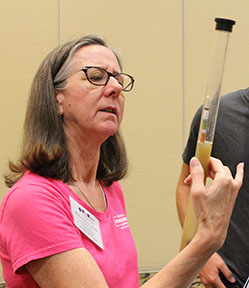
A home winemaker at any level will need a hydrometer and test jar. A hydrometer is a glass instrument that measures Brix (a measurement of sugar concentration within a liquid in grams per milliliter). The more sugar that is in a juice or must sample, the more dense the liquid and therefore more buoyant the hydrometer. Density of a solution is also temperature contingent; the winemaker must use the chart that comes with the hydrometer (or find a chart online) to allow for temperature variances of the sample in relation to ambient temperatures. A test jar is a cylindrical container that will hold the sample to be tested and allow for easy viewing of the hydrometer. It is similar in appearance to a graduated cylinder, but without demarcations. There are varying styles of hydrometer, the standard ranging from 0 °Brix to 30 °Brix. A more accurate option for hydrometers would be a set that has a narrower range per individual hydrometer (-5 to 5 °Brix, 0 to 8 °Brix, 8 to 16 °Brix, etc.) Having a more narrow range on the individual hydrometers will give greater precision of each measurement. A precision hydrometer with a range from -5 to 5 °Brix is especially useful to help ascertain dryness in a wine.
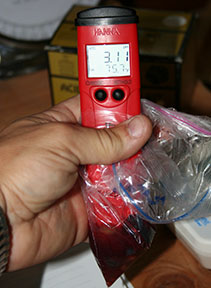
Another essential and easy-to-use instrument to measure sugar content of must is a refractometer. A refractometer measures the sugar content of a solution, like grape juice, by measuring the degrees of refraction of light beams, contingent upon the amount of solute (sugar) dissolved in solvent (water). Refractometers can be used pre-fermentation to track the Brix development in ripening grapes or to assess the sugar content of the must before inoculation of yeast. Once yeast has been added and alcoholic fermentation commences, a hydrometer should be used to measure gravity in place of a refractometer because the alcohol changes the density of the solvent and the refraction measurements.
For the home winemaker producing smaller batches and averaging 5–20 gallons (19–76 L) per year, some of the basic testing equipment will be largely sufficient. The primary instrument for consideration would be the pH meter. Some home winemakers will rely on pH testing strips, similar to those used in chlorine pool testing. These should not be used as the pH level is determined via color comparison, which is highly subjective. Very affordable and reliable pH meters are offered by Milwaukee and Hanna Instruments. It is important to invest in a model with a temperature probe as well, as temperature will affect the readings of the pH meter. The Milwaukee pH54 model and the Hanna Instruments HI98128 model both have an attached temperature probe and a digital readout to 0.1 pH or 0.01 pH respectively. This is an affordable and very precise option for the smaller production home winemaker.
It is important to maintain any device with a probe properly, ensuring that it is stored in its proper storage solution and calibrated with the proper buffers prior to use to ensure precision and accuracy. A pH probe will need to be replaced every 12–18 months, which both of these aforementioned units allow for. This pH meter will also be useful in measuring total acidity (TA) of wine. To perform an accurate TA test, in addition to the pH meter, you will also need a stir plate and stir bar, laboratory glassware, and a graduated burette with a stand. This will set you up for a successful manual titration of total acidity using sodium hydroxide. Always obtain your reagents like sodium hydroxide from a reputable source to ensure they are fresh and accurately diluted.
For the most basic and affordable means of free SO2 testing, Accuvin makes a very easy test kit. The test kits contain 10 tests for free SO2. The free SO2 level is determined via a color comparison, again making the accuracy more of an educated guess than a precise reading. For a novice home winemaker, this may be sufficient to maintain a healthy level of free SO2 in the wine.
Another important criterion for any home winemaker to evaluate is the completion of their malolactic fermentation. Accuvin makes a kit to test for the presence of malic acid. If the presence of malic acid is detected, the fermentation can be assumed to be incomplete. Again, the test uses color comparison to ascertain the results, which can be very subjective. The kit can be confusing for novice winemakers or scientists, so pay close attention to the directions that come with the kit.
Lab Equipment for Mid-Range Home Wine Production
Once the winemaking “bug” has fully set in and the winemaker desires to ramp up annual production to between 20–60 gallons (76–227 L), some aspects of the home lab may also be worth upgrading. The previously mentioned handheld pH meters, while effective, can be upgraded to more accurate models. The Milwaukee 150 model and the Hanna Instruments Edge digital pH meter both offer multiple points of calibration using up to five buffers. This allows for a more accurate calibration and results for pH testing. The Hanna Instruments Edge even has USB ports to allow it to be connected to a computer for the storage of test results. Both models have larger, easy-to-read screens and are more of a bench top model, rather than a handheld style. The same maintanence of calibration and careful storage of the electrode in its proper storage solution is absolutely necessary.
For total acidity counts, the former manual titration method is straight forward, relevant, and accurate for the scaled up home winemaker. If manual titration is too taxing and you would like to upgrade your accuracy of total acidity testing, Hanna Instruments makes a small bench top automatic titrator that tests for total acidity, Hanna Instruments model HI84502U-01. This small “mini titrator” will help to alleviate the precarious manual titration with its automatic dosing. For the winemaker who has to test more than six batches of wine, this can save hours of time in the lab. Vinmetrica also has their SC-200 model that will help to read pH, while still requiring the manual titration. This would be a more cost effective, but still laborious, way to calculate total acidity.
When making this much wine annually, there are also more accurate options for measuring free SO2. Vinmetrica’s SC-100 model measures free SO2 with a relatively easy manual titration. Its accuracy is high and the unit itself is sturdy, reliable, and uncomplicated. This is a much more accurate way of testing the free SO2 than the previously mentioned Accuvin kits. While requiring a higher monetary investment ($284 directly from Vinmetrica), this unit has the capacity to provide more accuracy by narrowing down the precise sulfite concentration in parts per million, rather than a range determined by color comparison.
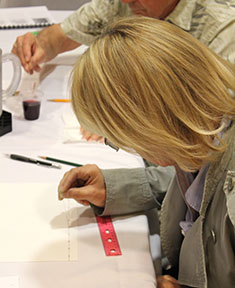
You can also progress beyond the Accuvin color comparison kits for the malolactic fermentation testing. Paper chromatography kits are inexpensive and have the capacity to conduct hundreds of tests. An advantage of chromatography is that it will show the winemaker the progression, if not completion of the secondary fermentation. By observing the chromatography test results, the winemaker can determine if the wine has yet to begin (no lactic acid), is at a mid-point (if you see both malic and lactic acid), or has completed malolactic fermentation (the level of sensitivity is 100 mg/L, but some MLFs stop at 200 mg/L. They are dead as a doornail but the spot will still show.) This may be especially desirable for the winemaker who wishes to put a white wine only partially through malolactic fermentation. While the chromatography method does not provide quantifiable, numerical results, it does give the winemaker a more detailed depiction of the malolactic process.
Lab Equipment for Large Home Wine Production
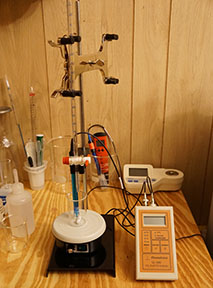
free SO2.
Then there are those winemakers among us who have joined the “barrel-plus club,” making over 60 gallons (227 L) a year. At this stage, winemaking has progressed to a very involved undertaking and the winemaker may desire much more technical equipment to produce a more sophisticated and consistent wine from vintage to vintage. Vinmetrica’s SC-300 model (retailing for $485) has junctions for both pH probes as well as an ORP probe for free SO2 testing. This unit is very user-friendly and can test for pH, titratable acidity (TA), and free SO2. Vinmetrica also offers a yeast assimilable nitrogen (YAN) testing kit that may be used in conjunction with their SC-200 and SC-300 models. It tests very quickly and is highly precise.
For the home winemaker who prefers to eliminate the precarious task of manual titration, Hanna Instruments makes a variety of automatic titrators. They have the previously mentioned “mini” styles, a separate unit for TA and free SO2. Hanna also offers a large-scale wine titrator, the HI901W, complete with multiple calibration points, multiple probes and functions, full automatic titration, and data storage. These units have customizable features to tailor the unit to your individual testing preferences and standards. While they are more costly (the HI901W retails for about $3,000), if maintained properly they can be a one-time investment of an extremely useful and versatile testing unit. This unit is capable of much more testing, including YAN, total SO2, reducing sugars, volatile acids, and many others. This unit would be appropriate for the most serious and dedicated home winemakers.
Other Household Equipment
After these crucial, basic panels of tests are covered, there may be a few other materials that would be conducive to wine testing. To perform heat stability tests, a slow cooker Crock-Pot can be used to create a hot water bath with consistent temperatures. A small refrigerator or freezer can be useful to conduct cold stability tests as well as for practical purposes of storing yeast, enzymes, and other supplies that must be refrigerated.
The home winemaking laboratory is a crucial aspect of producing consistent, good quality, homemade wines. This will allow you to see and understand the quantitative factors in your wine, making it more stable and replicable for future vintages.



